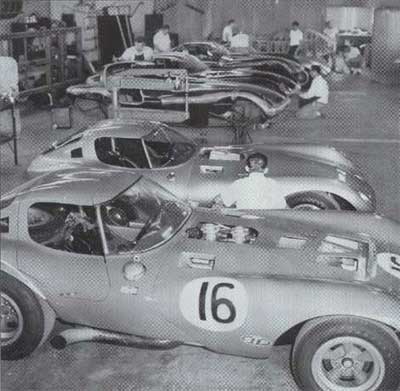Bill Thomas had the answer to Carroll Shelby’s Cobra in his head, all he needed was someone to provide some backing and support in order for him to be able to construct it. Due to the AMA’s ban on factory support, that seemed like it would be an impossibility in the early ‘60s but things being what they were and Ford’s Cobra being the holy terror that it was, good luck shone down on Bill Thomas, for a time anyway.
Bill Thomas had been building Corvettes into capable road racers for some time before the Cobra made its debut. The Corvettes were not in a very good position to compete due to a weight and power disadvantage compared to Shelby’s little English sports car with V8 power. Thomas set out to correct this problem by building a specialty car that would beat the Cobra at its own game. Due to his connections at Chevrolet, Thomas got the very quiet nod to proceed with this project and he received backdoor factory support.
The Cheetah would use Corvette mechanical pieces wrapped in a custom body and chassis and put Chevrolet back on top and stop the Cobras dead in their tracks. Well, that was the plan anyway. To be eligible for SCCA competition as a production car, 100 examples had to be produced, and without those numbers the Cheetah would not be eligible to compete in the same class as the Cobra. This would be a massive undertaking for the small operation of Thomas and frankly, things never really got going as they were supposed to.
Starting out with a tube-frame chassis, Thomas opted for a lot of engine setback to balance out the car. The motor was placed so far back that the drivers head was nearly poking out the rear window and he was sitting virtually on top of the rearend housing. The motor was a stroked small-block displacing in the neighborhood of 380ci and topped with Rochester fuel injection. These FI units had been tuned and tweaked by Thomas to working order far superior to that of those directly off of the assembly line. The motor supposedly made 475 hp. Not too shabby in a car that was extremely lightweight and fiberglass-bodied (although at least one aluminum bodied example was built). A T-10 four speed got things moving along.
Chevrolet actually tested the cars at the proving ground and concluded that the chassis was not rigid enough and would be very difficult to drive. Judging by the fact that the first couple of cars were wrecked by professional drivers almost immediately, we’d agree with that assessment.
Suspension pieces were straight from the Corvettes of the day and the brakes were four wheel drums, which seems insane, but a production Vette was nearly twice as heavy as a Cheetah, so the drums probably were competent at getting this little baby hauled down for the corners.
The first cars hit the track at the end of 1963 and flaws in the design were immediately evident. Racers complained that the body, although neat looking, basically turned the car into a convection oven. The problem was so bad that it is documented that one owner sawed the roof off of his and ran it as a convertible. There were also problems with the gullwing doors actually acting like gulls and flying off the cars at high speeds.
In 1964, because the production run was nowhere close to 100 cars, the Cheetahs found themselves racing against mid-engine cars like Chaparrals. Despite what you’re thinking, they held their own on the track.
But it didn’t help that Thomas’s factory went all flambé on itself in 1965, rendering the assembly line closed and the production run stopped at a measly 16 original cars, eight of which are known to exist today.
There have been a couple of kit car companies which have sold knock-off bodies and such, but there are fewer than 10 real Cheetahs out there today, a couple of which actually still race on vintage circuits. Kudos to their owners on that.




























